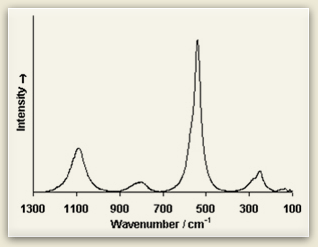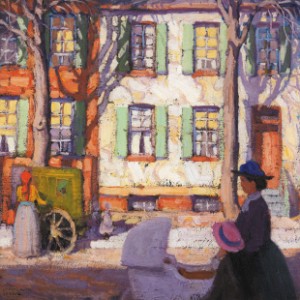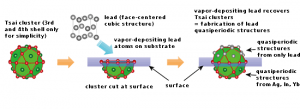Cultural heritage and the importance of pigments and databases
Unlike Thom (Ian Thom, curator at the Vancouver Art Gallery), I believe that the testing was important. Knowing the spectra emitted by the pigments in Hurdy Gurdy and Autumn Harbour could help to set benchmarks for establishing the authenticity of the pigments used by artists (Harris and others) in the early part of Canada’s 20th century.
Europeans and Americans are more advanced in their use of technology as a tool in the process of authenticating, restoring, or conserving a piece of art. At the Chicago Institute of Art they identified the red pigment used in a Renoir painting as per my March 24, 2014 posting,
… The first item concerns research by Richard Van Duyne into the nature of the red paint used in one of Renoir’s paintings. A February 14, 2014 news item on Azonano describes some of the art conservation work that Van Duyne’s (nanoish) technology has made possible along with details about this most recent work,
Scientists are using powerful analytical and imaging tools to study artworks from all ages, delving deep below the surface to reveal the process and materials used by some of the world’s greatest artists.
Northwestern University chemist Richard P. Van Duyne, in collaboration with conservation scientists at the Art Institute of Chicago, has been using a scientific method he discovered nearly four decades ago to investigate masterpieces by Pierre-Auguste Renoir, Winslow Homer and Mary Cassatt.
Van Duyne recently identified the chemical components of paint, now partially faded, used by Renoir in his oil painting “Madame Léon Clapisson.” Van Duyne discovered the artist used carmine lake, a brilliant but light-sensitive red pigment, on this colorful canvas. The scientific investigation is the cornerstone of a new exhibition at the Art Institute of Chicago.
There are some similarities between the worlds of science (in this case, chemistry) and art (collectors, institutions, curators, etc.). They are worlds where one must be very careful.
The scientists/chemists choose their words with precision while offering no certainties. Even the announcement for the discovery (by physicists) of the Higgs Boson is not described in absolute terms as I noted in my July 4, 2012 posting titled: Tears of joy as physicists announce they’re pretty sure they found the Higgs Boson. As the folks from ProsPect Scientific noted,
This is why the science must be tightly coupled with art expertise for an effective analysis. We cannot do all of that for David [Robertson]. [He] wished to show a match between several pigments to support an interpretation that the ‘same’ paints were used. The availability of Hurdy Gurdy made this plausible because it offered a known benchmark that lessened our dependency on the databases and art-expertise. This is why Raman spectroscopy more often disproves authenticity (through pigment anachronisms). Even if all of the pigments analysed showed the same spectra we don’t know that many different painters didn’t buy the same brand of paint or that some other person didn’t take those same paints and use them for a different painting. Even if all pigments were different, that doesn’t mean Lawren Harris didn’t paint it, it just means different paints were used.
In short they proved that one of the pigments used in Autumn Harbour was also used in the authenticated Harris, Hurdy Gurdy, and the other pigment was in use at that time (early 20th century) in Canada. It doesn’t prove it’s a Harris painting but, unlike the Pollock painting where they found an anachronistic pigment, it doesn’t disprove Robertson’s contention.
To contrast the two worlds, the art world seems to revel in secrecy for its own sake while the world of science (chemistry) will suggest, hint, or hedge but never state certainties. The ProSpect* Scientific representative commented on authentication, art institutions, and databases,
We know that some art institutions are extremely cautious about any claims towards authentication, and they decline to be cited in anything other than the work they directly undertake. (One director of a well known US art institution said to me that they pointedly do not authenticate works, she offered advice on how to conduct the analysis but declined any reference to her institution.) We cannot comment on any of the business plans of any of our customers but the customers we have that use Raman spectroscopy on paintings generally build databases from their collected studies as a vital tool to their own ongoing work collecting and preserving works of art.
We don’t know of anyone with a database particular to pigments used by Canadian artists and neither did David R. We don’t know that any organization is developing such a database.The database we used is a mineral database (as pigments in the early 20th century were pre-synthetic this database contains some of the things commonly used in pigments at that time) There are databases available for many things: many are for sale, some are protected intellectual property. We don’t have immediate access to a pigments database. Some of our art institution/museum customers are developing their own but often these are not publicly available. Raman spectroscopy is new on the scene relative to other techniques like IR and X-Ray analysis and the databases of Raman spectra are less mature.
ProSpect Scientific provided two papers which illustrate either the chemists’ approach to testing and art (RAMAN VIBRATIONAL STUDY OF PIGMENTS WITH PATRIMONIAL INTEREST FOR THE CHILEAN CULTURAL HERITAGE) and/or the art world’s approach (GENUINE OR FAKE: A MICRO-RAMAN SPECTROSCOPY STUDY OF AN ABSTRACT PAINTING ATTRIBUTED TO VASILY KANDINSKY [PDF]).
Canadian cultural heritage
Whether or not Autumn Harbour is a Lawren Harris painting may turn out to be less important than establishing a means for better authenticating, restoring, and conserving Canadian cultural heritage. (In a June 13, 2014 telephone conversation, David Robertson claims he will forward the summary version of the data from the tests to the Canadian Conservation Institute once it is received.)
If you think about it, Canadians are defined by the arts and by research. While our neighbours to the south went through a revolutionary war to declare independence, Canadians have declared independence through the visual and literary arts and the scientific research and implementation of technology (transportation and communication in the 19th and 20th centuries).
Thank you to both Tony Ma and David Robertson.
Finally, Happy Canada Day on July 1, 2014!
* ‘ProsPect’ changed to ‘ProSpect’ on June 30, 2014.
ETA July 14, 2014 at 1300 hours PDT: There is now an addendum to this series, which features a reply from the Canadian Conservation Institute to a query about art pigments used by Canadian artists and access to a database of information about them.

!["Autumn Harbour" [downloaded from http://metronews.ca/news/vancouver/1051693/chemists-in-vancouver-to-use-lasers-to-verify-group-of-seven-painting/]](http://www.frogheart.ca/wp-content/uploads/2014/06/autumn-harbour-300x198.jpg)


![[Downloaded from: http://www.chemistryviews.org/details/ezine/1371029/Modeling_Molecular_Properties_and_Opera.html]](http://www.frogheart.ca/wp-content/uploads/2013/04/Turandot_Chemistry_Opera-300x231.jpg)